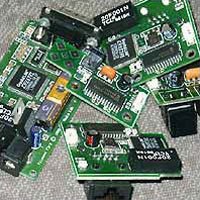
Distributed Embedded Systems and the “Filaments”
Tags: distributed, mit, pcbs
When I first joined the MIT Media Lab as a sophomore in 1998 it was to help the Physics and Media Group finish off an embedded networking project that a graduating student had started. The idea had been conceived several years previously. The group was regularly building little devices that all needed to talk to each other, but there was no good way to stick them directly on the network. The usual approach, which was also great for debugging, was to attach each device to a computer via a serial port. The question was raised: why can't we have a simple chip that essentially connects a serial port directly to the Ethernet? Thus was the Filament project born.
Rather than attempting to go straight to a chip-level solution, my job was to develop some board-level prototypes that the group could immediately take advantage of. The board on the left in this picture is the Filament version 3 revision 3 (F3R3), which was the most successful version. It had a serial port on one end and an Ethernet port on the other. I made about a hundred of these, and we used them for everything. Most notably, they were the glue behind the interactive dining room table in The Un-Private House, an exhibition at the Museum of Modern Art (MoMA) in New York City in 1999. We wrote an invited paper about it for the IBM Systems Journal.
The other boards on the right were part of a system of building-control modules that left behind Ethernet for an ad-hoc RS-422 network that could operate using the modular elements originally developed for track lighting. This was somewhat less successful, for all the usual reasons that ad-hoc power+data networks are tricky. We demonstrated this technology at the Media House expo in Barcelona in 2001.



